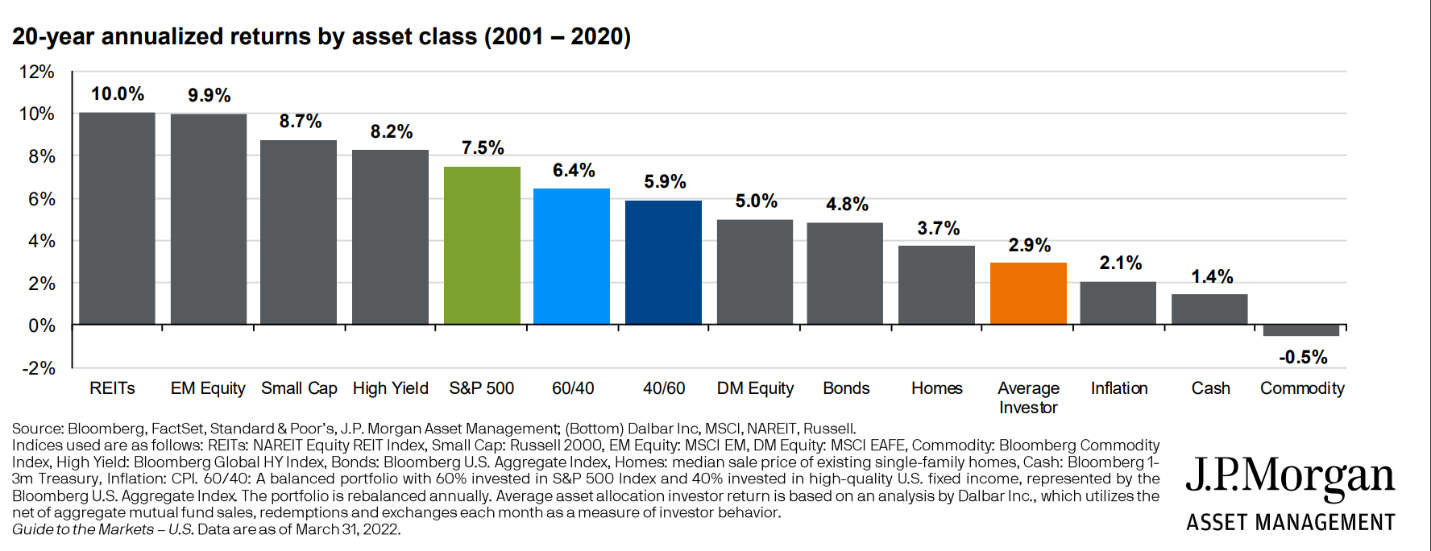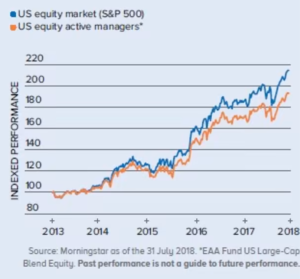Successful investing is counter-intuitive
Successful investing is counter-intuitive as the key tenets are simple to remember, but hard to do.
Those who have knowledge, don’t predict. Those who predict, don’t have knowledge.
(Lao Tzu)

The bar graph above shows the historical average annualized return for different asset classes over the past 20 years. Specifically, I want to draw your attention to the Average Investor return of 2.9% (orange bar) versus the S&P 500 return 7.5% (green bar), which is essentially a US large-cap blend (growth and value) fund. Notice the great difference (4.6%) between investor versus S&P 500 return. Why? Or perhaps, why not?
This year has had more than its share of cascading events and dramas: COVID (still…sigh), Ukraine, high inflation, rising interest rates, crypto implosion, growth stocks’ decline, stalling/falling home prices, etc. Given continued high inflation (8.3% latest), cash still nets a negative return. To combat inflation, rising rates are sending speculative and/or expensive investments (e.g., crypto and growth sector) down…fast. Moreover, although stocks are one of the best ways to outrun inflation (e.g., businesses can raise prices), the market has increasingly felt like one big, scary roller coaster ride. As is, many investors are likely feeling stuck between a rock and a hard place. Damned if you do and damned if you don’t!
Whether faced with calm or turbulent markets, I think it’s important to remind ourselves (occasionally) what I consider the key tenets of successful investing.
#1: Buy low, sell high.
This oft-cited strategy is far easier said than done. Reason being, people are emotional and easily influenced by fear or greed (herd mentality). Moreover, it requires that you be a contrarian, which means finding the confidence and courage to zig when the majority zag. For example, since the Great Recession (January, 2009 – September, 2022), US growth sector (tech) has outperformed value sector (banking) by a wide margin – 277%. During that same period, the US market has outperformed the international market by 286%. As is, the growth sector and US market are (still) expensive relative to the value sector and international market. Additionally, since markets move in cycle, the value sector and international market seem overdue for outperformance. Thus, one would assume that investors would sell expensive (“high”) investments in the growth sector and US market and buy cheap (“low”) investments in the value sector and international market. Unfortunately, this is yet a noticeable trend in the market place. My guess is most investors assume that that which had outperformed for more than a decade will continue to do so (recency bias). Rather than zig, the inclination to zag is still strong and pervasive.
#2: Passive vs Active
Although it may seem smart and proactive to trade often and chase after hot investments or fund managers, research has shown that for most investors the best strategy is to buy a diversified portfolio and then hold it for as long as possible. As is, passive funds (e.g., index funds that hold the market) have consistently beaten active funds (e.g., managed funds that are composed of selected stocks). (See Exhibit 1.) Reason being, passive funds offer great diversification at a very low cost. The average cost (or expense ratio) for passive funds is 0.12% vs 0.60% for active funds.[1] Over time, the great difference in costs further compounds and amplifies passive funds’ outperformance over active funds.
Exhibit 1: Performance of US Active Fund Managers vs The Market (Passive Fund Managers)

#3: Time in the market is more important than timing the market
When buying an investment, consider holding it for at least 10 years, but ideally forever. Reason being, the money is not in the buying and selling of investments, but rather in the holding. When you hold investments, you make money two ways: 1) receive quarterly dividends, which typically account for one-third of total returns 2) enjoy market appreciation of investments, which typically account for two-third of total returns, as their value increases over time. Additionally, by holding investments, you give it precious time to compound as reinvested dividends further amplify the market appreciation of investments. Howard Marks, co-founder of Oaktree and long-time investor, wisely observed: Those who try to time markets are like those running from bus stop to bus stop in hopes of catching the fastest route to their destination. What typically happens is that they end up missing (all) the bus.
#4: Limit your downside (risk) and the upside (return) will take care of itself
When people invest, they often think of ways to maximize return rather than minimize risk. Thing is, it’s easier to try and minimize risk than ensure high return. Interestingly, by limiting your downside, you increase your potential upside. Here are some ways to limit your downside risk:
· Live (well) below your means; target a 30% savings rate, at least. This way, you have less of a need to take on greater investment risk in the hopes of higher return.
· Have a 10-12 month emergency fund so you can pay for life’s “incidental” expenses rather than be forced to sell your investments, especially in a down market.
· Hold a diversified portfolio by: asset class, market cap, geography, style (growth vs value). Given the complexity and interplay between economies, politics, etc, it’s impossible to pick investment winners consistently over time. For 99% of investors, the best strategy is to buy and hold THE MARKET.
· Dollar cost average (via auto investing) your money into the market so that you buy some shares high, some low, but, collectively, most shares somewhere in between.
By limiting your downside risk, you increase your ability to buy and hold and, thereby, increase your probability for positive upside return.
Final thoughts…
Given the increased turbulence in markets, I think it’s important to reiterate what I consider key tenets of successful investing, especially for investors who are growing increasingly scared but still need to invest and/or stay invested. My hope is that they will serve as both guide and anchor for your investing efforts. For most of you, the tenets are not new. Good news is they are simple to remember. Bad news is they are counter-intuitive and often hard to follow through (consistently).
Successful investing is simple. Maybe that’s why it’s hard.
[1] “Fund Fees’ Continued Decline Is a Win for Investors,” Morningstar, July 2022
RECENT POSTS
December 2023
With year end, I want to share with you some of my personal and professional experiences and observations and the insights they’ve given me regarding gratitude and wealth.
December 2023
For many workers, making the most of your 401k is one of the best things you can do to increase your investment returns exponentially.
October 2023
Countering conventional wisdom, my professional experience has taught me that successful financial planning is based on magic and then on math; on you and then on me.
Get a free financial education.
Learn more about key financial topics, such as investing, 401k, disability insurance, paying for a home, at your own convenience. Sign up for Women’s Wealth monthly newsletter and have relevant information delivered to your inbox.

Live life on your own terms.
Do you find yourself constantly stressed or bored at work and wondering when you can live life on your own terms? Learn how to harness money’s energy and begin to create your life rather than manage it.
CONNECT
Anh Thu Tran
Women’s Wealth LLC
P.O. Box 1522
Tacoma, WA 98401
anhthu@womenswealthllc.com
(206) 499-1330
Women’s Wealth LLC is a Washington State registered investment advisor. The presence of this website on the Internet shall not be directly or indirectly interpreted as a solicitation of investment advisory services to persons of another jurisdiction unless otherwise permitted by statute. Follow-up or individualized responses to consumers in a particular state by our firm in the rendering of personalized investment advice for compensation shall not be made without our first complying with jurisdiction requirements or pursuant an applicable state exemption. For information concerning the status or disciplinary history of a broker-dealer, investment advisor, or their representatives, a consumer should contact their state securities administrator.
© 2021 Women’s Wealth LLC. All rights reserved. | Design by Erin Morton Creative, LLC.



